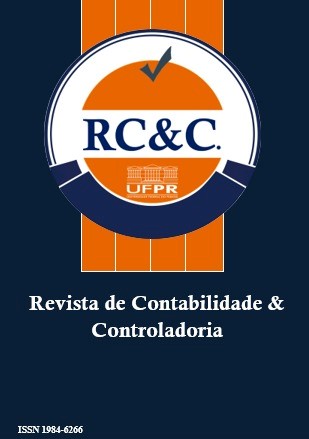Características de um Gestor Executivo que Contribuem para a Eficiência Financeira nas Organizações do Terceiro Setor: Um Estudo na Organização de Fundo Infantil Brasil
DOI:
https://doi.org/10.5380/rcc.v15i3.90128Palavras-chave:
Eficiência financeira, Gastos administrativos, Sucessão executiva.Resumo
O terceiro setor tem-se expandido e se tornado um crescente provedor de serviços à sociedade. À medida que ele cresce, também cresce a exigência por eficiência financeira na prestação de serviços à comunidade. Um dos indicadores utilizados para se medir essa eficiência financeira é denominado gastos administrativos. Assim, o objetivo deste trabalho é investigar as características observáveis de um gestor executivo que contribuem para a eficiência financeira no terceiro setor. Com base nas teorias dos altos escalões, de sucessão executiva e da eficiência financeira, foi desenvolvida uma pesquisa quantitativa, com a intenção de identificar essas características. Também foram analisadas as Demonstrações de Resultado do Exercício (DREs), de 2009 a 2018. Notou-se, a partir dos modelos de efeitos fixo e aleatório, e do Feasible Generalized Least Squares (FGLS), que tanto a participação do Conselho de Administração quanto a do CEO pregresso, no processo de contratação de um CEO, podem ser fatores importantes para a eficiência financeira da organização. Outrossim, mostrou que as variáveis envolvidas em parcerias podem afetar o indicador de gastos administrativos.
Referências
Adro, Francisco José Nave do & João Carlos Correia Leitão (2020). “Leadership and Organizational Innovation in the Third Sector: A Systematic Literature Review”. International Journal of Innovation Studies 4, nº 2 (junho de 2020), p. 51–67.
Bach-Mortensen, A. M., Lange, C. L.B. & Montgomery, P. (2018). Barriers and facilitators to implementing evidence-based interventions among third sector organizations: a systematic review. Implementation Science, 13(103), p.1-19.
Barro, R. J. & Lee, J. W. (1996). International measures of schooling years and schooling quality. The American Economic Review, 86(2), p. 218-223.
Bartuseviciene, I. & Šakalytė, E. (2013). Organizational assessment: effectiveness vs. efficiency. Social Transformation in Contemporary Society, 1, p. 45-53.
Berns, K. V. D. & Klarner, P. (2017). A review of the CEO succession literature and a future research program. Academy of Management Perspectives, 31(2), p.83-108.
Bridge, S., Murtagh, B., & O'Neill, K. (2020). Understanding the social economy and the third sector. Bloomsbury Publishing.
Brugni, T. V.; Fávero, L. P. L.; Klotzle, M. C.; Pinto, A. C. F. (2018). Conselhos de Administração Brasileiros: uma análise à luz dos formulários de referência. Advances In Scientific and Applied Accounting, v. 11, n. 1, p. 146-165.
Burkart, C., Wakolbinger, T & Toyasaki, F. (2018). Funds allocation in NPOs: the role of administrative cost ratios. Central European Journal of Operations Research, 26(2), p. 307-330.
Chavan, M. (2009). The balanced scorecard: a new challenge. Journal of Management Development, 28(5), p. 393-406.
Comini, G. M. & Fischer, R. (2009). When Cinderella gazes at herself in the mirror: the succession issue in NGOs. International Leadership Journal, 1(2), p. 4-26.
Drucker, P. F. (1977). Management: tasks, responsabilities, practice. London: Pan.
Eisenhardt, K. M. (1989). Building theories from case study research. Academy of Management Review, 14(4), p. 532-550.
Finkelstein, S.; Hambrick, D. C. (1996). Strategic Leadership: Top Executives and Their Effects on Organizations. Australian Journal Of Management, v. 22, n. 2, p. 221224.
Firebaugh, G., Warner, C. & Massoglia, M. (2013). Fixed effects, random effects, and hybrid models for causal analysis. In Morgan, S. (Org.). Handbook of Causal Analysis for Social Research. New York: Springer. p. 113-132.
Gertler, P. J., Martínez, S., Premand, P., Rawlings, L. B. & Vermeersch, C. M. J. (2018). Avaliação de impacto na prática. (2.ed). Washington D.C.: Grupo Banco Mundial.
Gil, A. C. (2009). Como elaborar projetos de pesquisa. São Paulo: Atlas.
Gottesman, A. A.; MOREY, M. R.(2006). Manager education and mutual fund performance. Journal Of Empirical Finance, v. 13, n. 2, p. 145-182.
Gupta, A. K.; Govindarajan, V. (1986). Resourcesharing among SBUs: Strategic antecedents and administrative implications. Academy of Management Journal, v. 29, n. 4, p. 695-714.
Hair Jr., J. F., Black, W. C., Babin, B. J., Anderson, R. E. & Tatham, R. L. (2009). Análise Multivariada de dados. (6.ed). Porto Alegre: Bookman.
Hambrick, D. C. & Mason, P. A. (1984). Upper echelons: the organization as a reflection of its top managers. Academy of Management Review, 9(2), p. 193-206.
Hambrick, D. C. (2007). Upper echelons theory: an update. Academy of Management Review, 32(2), p. 334-343.
Kaplan, R. S. (2001). Strategic performance measurement and management in nonprofit organizations. Nonprofit Management and Leadership, 11(3), p. 353-370.
Kumar, S. & Gulati, R. (2009). Measuring efficiency, effectiveness and performance of Indian public sector banks. International Journal of Productivity and Performance Management, 59(1), p. 51-74.
Lippert, R. L.; Porter, G. (1997). Understanding CEO pay: A test of two pay-to-performance sensitivity measures with alternative measures of alignment and influence. Journal of Business Research, v. 40, n. 2, p. 127-138.
Low, J. (2000). The value creation index. Journal of Intellectual Capital, 1(3), p. 252-62.
Mertens, S. (1999). Nonprofit organisations and social economy: two ways of understanding the third sector. Annals of Public and Cooperative Economics, 70(3), p. 501-520.
Moulaert, F. & Ailenei, O. (2005). Social economy, third sector and solidarity relations: a conceptual synthesis from history to present. Urban Studies, 42(11), p. 2037-2053.
Mouzas, S. (2006). Efficiency versus effectiveness in business networks. Journal of Business Research, 59(10-11), p. 1124-32.
Mueller, G. C. & Barker, V. L. (1997). Upper echelons and board characteristics of turnaround and nonturnaround declining firms. Journal of Business Research, 39(2), p. 119-134.
Neely, B. H., Lovelace, J. B., Cowen, A. P. & Hiller, N. J. (2011). Metacritiques of upper echelons theory: verdicts and recommendations for future research. Journal of Management, 46(6), p. 1029-62.
Nunnenkamp, P. & Öhler, H. (2012). Funding, competition and the efficiency of NGOs: an empirical analysis of non-charitable expenditure of US NGOs engaged in foreign aid. Kyklos, 65(1), p. 81-110.
Peni, E. (2014). CEO and Chairperson characteristics and firm performance. Journal of Management and Governance, v. 18, n. 1, p. 185-205.
Rosenzweig, M. R. (1995). Why are there returns to schooling? The American Economic Review, 85(2), p. 153-158.
Spector, P. E. & Brannick, M. T. (2011). Methodological urban legends: the misuse of statistical control variables. Organizational Research Methods, 14(2), p. 287-305.
Suits, D. B. (1957). Use of dummy variables in regression equations. Journal of the American Statistical Association, 52(280), p. 548-551.
Tinkelman, D. & Mankaney, K. (2007). When is administrative efficiency associated with charitable donations? Nonprofit and Voluntary Sector Quarterly, 36(1), p. 41-64.
Vieira, S. (2009). Como elaborar questionários. São Paulo: Atlas.
Virany, B., Tushman, M. L. & Romanelli, E. (1992). Executive succession and organization outcomes in turbulent environments: an organization learning approach. Organization Science, 3(1), p. 72-91.
Waldman, D. A., Javidan, M. & Varella, P. (2004). Charismatic leadership at the strategic level: a new application of upper echelons theory. The Leadership Quarterly, 15(3), p. 355-380.
Yin, R. K. (2003). Estudo de caso. Porto Alegre: Bookman.
ZIDANE, Youcef J.-T.; OLSSON, Nils O. E. (2017). Defining project efficiency, effectiveness and efficacy. International Journal of Managing Projects in Business, v. 10, n. 3, p. 621-641.
Downloads
Publicado
Como Citar
Edição
Seção
Licença
Copyright (c) 2023 RC&C. Revista de Contabilidade e Controladoria

Este trabalho está licenciado sob uma licença Creative Commons Attribution-NonCommercial-NoDerivatives 4.0 International License.
Os trabalhos publicados na RC&C. Revista de Contabilidade e Controladoria estão sujeitos aos seguintes termos:
1.1. A RC&C. Revista Contabilidade & Controladoria, através do Programa de Pós-Graduação em Contabilidade do Departamento de Contabilidade - Setor de Ciências Sociais Aplicadas - Universidade Federal do Paraná, retém os direitos de propriedade (direitos autorais) dos trabalhos publicados e incentiva e permite sua reutilização sob a Licença Creative Commons 4.0 de CC Attribution-NonCommercial-ShareAlike 4.0, para que possam ser copiados, utilizados, disseminados, transmitidos e exibidos publicamente, desde que:
1.1.a. A autoria e a fonte original da publicação (periódico, editora, URL e DOI do trabalho) sejam citadas.
1.1.b. Não sejam utilizados para fins comerciais ou onerosos.
1.1.c. A existência e as especificações desta licença de uso são mencionadas.
1.2. A publicação atribuirá a cada artigo um Identificador de Objeto Digital (DOI).









